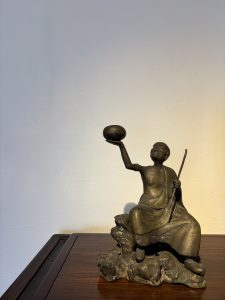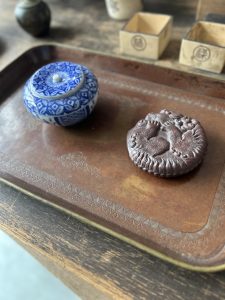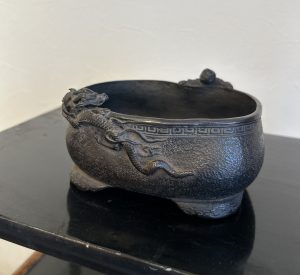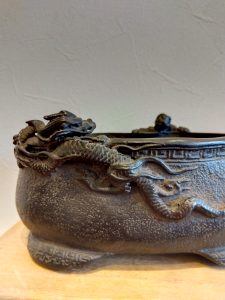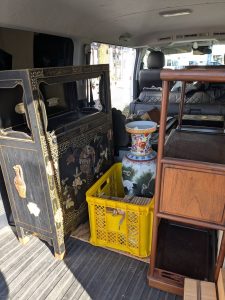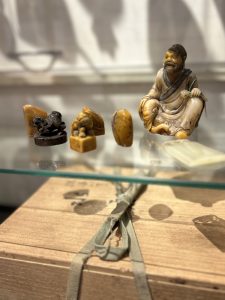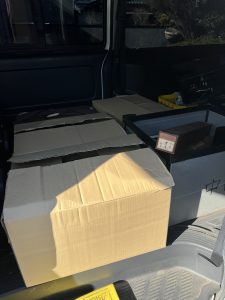ボードゲームを愛する羽人とは(愛知県名古屋市千種区姫池通 骨董買取 古美術風光舎)
2025.12.17
先日、大阪市立美術館を訪れました。大規模改修工事が行われ今年の3月にリニューアルオープンしたのですが、あまりにもお久しぶりのため、変化が分からず…。それでもエントランスホールの広々とした空間は、これぞと美術館!といった趣があり気分を盛り上げてくれます。

今回は大阪万博のイタリア館の特別展が目的でしたが、そのチケットで館内の他の企画展示なども観ることができ、こちらの美術館がその質量をほこるアジアの仏教工芸、彫刻などの展示も拝見しました。写真撮影も可能とのことでしたが想像以上の展示物の数で、こんなに一度に中国の仏像を見たことがないので圧倒されてしまいました。
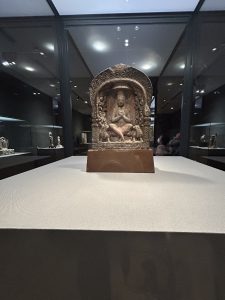
石造 菩薩交脚像龕(5世紀後半)
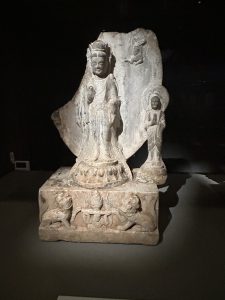
石造 菩薩三尊像(549年)
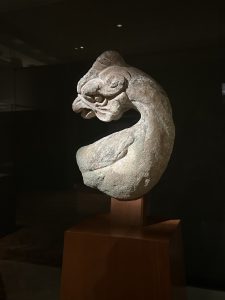
石造 鳳凰像(6世紀後半)

石造 太子半跏思惟像龕(492)
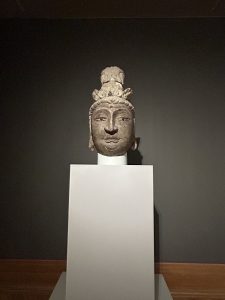
その中で、何とも不思議なポーズの小さな工芸品が目に留まりました。近づくと「青銅鍍金銀(せいどうときんぎん) 羽人(うじん)」中国後漢時代(1~2世紀)、と説明書きがあります。大阪市立美術館の新キャラクターのモデルとのこと。中国の不老不死の仙人で、羽人の像は似たものが世界で他に2点現存するのみだそうです。羽人という名前の通り、他の2体には羽があるそうですが、こちらの像には羽がないのが謎なのだとか。

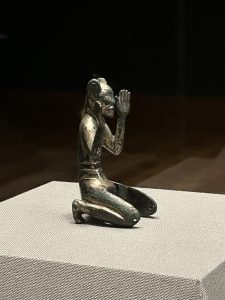
羽人は神様の世話をしたり、鳳凰に餌を与えたり、空を飛んで龍の車を先導するなどの役目があるそうですが、「六博(りくはく)」というボードゲームが好きで、隙あらば楽しんでいたというユニークな仙人だそうです。
シンプルな像に見えますが、青銅に金メッキが施された後に上から銀メッキが施されるという高度な技術で作られています。高さが10cm程で、目が吊り上がり、耳先が長く上に突き出している不思議な容貌です。なんとこの姿勢のまま走れるのではという説もあるのだとか。私には跪いて「降参!」と言っているようにしか見えないのですが…。
この羽人のポーズは、六博のゲームで使う箸や算木が入っていた容器を抱えている姿だそうで、両ひざの穴は、ネジのようなもので容器を固定するための穴だと推測されています。
美術館の壁には巨大な羽人の履歴書が展示されており、この美術館のユーモアのセンスが光っております。(写りが悪くてすみません)
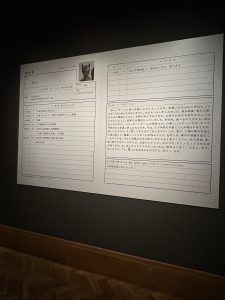
日頃のルーティンから頭を切り離しリフレッシュするには美術館巡りは効果的ですね。
天空のアトラスの顔はめパネルもありました!こちらはチケット不要です。
苦悶の表情で撮影されている方も…。
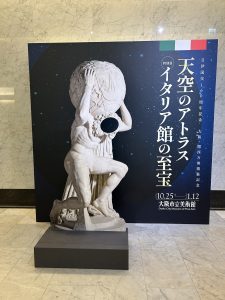
それでは、また次の機会に。(スタッフH)
The other day, I visited the Osaka City Museum of Fine Arts. It underwent major renovations and reopened this past March, but it had been so long since my last visit that I didn’t really notice much change… Still, the spacious entrance hall has that quintessential museum feel, instantly lifting your spirits.
My main purpose this time was the special exhibition on the Italian Pavilion at the Osaka Expo. However, the ticket also allowed me to see other special exhibitions within the museum. I viewed the museum’s impressive collection of Asian Buddhist crafts and sculptures, which it takes great pride in. Photography was permitted, but the sheer number of exhibits exceeded my expectations. I’d never seen so many Chinese Buddhist statues at once and was completely overwhelmed.
Stone Bodhisattva in Cross-legged Pose in a Niche (Late 5th Century)
Stone Triad of Bodhisattvas (549)
Stone Phoenix Statue (Late 6th Century)
Stone Niche with Prince in Half-Lotus Meditation Pose (492)
Among them, a small statue in a most peculiar pose caught my eye. Approaching it, I found an inscription: “Gilded Bronze and Silver Winged Immortal (Wujin).” Late Han Dynasty, China (1st-2nd century). It is said to be the model for the Osaka City Museum of Art’s new character. A Chinese immortal symbolizing eternal youth and immortality, only two other similar Winged Immortal statues are known to exist worldwide. True to its name, the other two statues have wings, but the mystery lies in why this particular statue lacks them.
Wujin is said to have duties like tending to gods, feeding phoenixes, and flying through the sky to guide dragon-drawn chariots. Yet he was also a unique immortal who loved the board game “Liubo” and would play whenever he got the chance.
Though the statue appears simple, it was crafted using advanced techniques: first gilded bronze, then overlaid with silver plating. Standing about 10 cm tall, it has an unusual appearance with slanted eyes and long, protruding ears. Some theories even suggest it could run in this posture. To me, though, it just looks like it’s kneeling and saying, “I surrender!”…
This winged figure’s pose apparently depicts it holding a container that held chopsticks and counting sticks used in the game of Rokuhaku. The holes in both knees are thought to be for fastening the container with something like screws.
A giant resume for this winged figure is displayed on the museum wall, showcasing the museum’s sense of humor. (Sorry for the poor photo quality)
Visiting museums is an effective way to disconnect from daily routines and refresh your mind.
There was also a face-in panel of Atlas holding up the sky! No ticket needed for this one.
Some people were photographed with expressions of agony…
Well then, until next time. (Staff H)
*******************
年の瀬にむけて、ご実家の整理やお片付けなどをされている方のご相談などが多くございます。
寒さが厳しくなってきましたので、お片付けなどくれぐれもご無理のないようになさってくださいませ。
風光舎では古美術品や骨董品の他にも絵画や宝石、趣味のお品など様々なジャンルのものを買受しております。
お片付けをされていて、こういうものでもいいのかしらと迷われているものでも、どうぞお気軽にご相談下さいませ。
また風光舎は、出張買取も強化しております。ご近所はもちろん、愛知県内、岐阜県、三重県その他の県へも出張いたします。
まずは、お電話お待ちしております。
愛知県名古屋市千種区姫池通
骨董 買取【古美術 風光舎 名古屋店】
TEL052(734)8444
10:00-18:00 OPEN
#出張買取#骨董#古美術#骨董品#絵画#版画#茶道具#刀剣#彫刻


